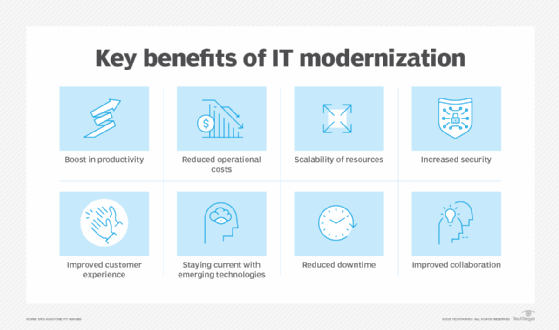IT modernization
What is IT modernization?
IT modernization is the process of updating an organization's information technology infrastructure, practices and systems to keep up with emerging technologies. A major revamp of an organization's IT backbone, IT modernization helps businesses stay competitive in today's constantly shifting digital landscape.
By embracing modern IT tools and technologies, such as artificial intelligence (AI) and cloud-based infrastructures, businesses undergo a digital transformation, enhancing efficiency, reducing expenses and strengthening their security posture.
The core concepts behind IT modernization
IT modernization affects many different components of the digital ecosystem, which includes everything from network resources to end-user hardware and storage systems.
It can involve embracing cloud computing and a cloud-first mindset. For example, migrating on-premises servers to a cloud-based model -- where a third party hosts a significant portion of the hardware and software -- enables businesses to consume resources on an as-needed basis.
This article is part of
What is digital transformation? Everything you need to know
While the specific areas of focus can vary, depending on the needs of an organization, the following are the common areas of improvement and key initiatives of IT modernization:
- Upgrading infrastructure and hardware.
- Improving applications and software.
- Updating data management techniques.
- Using cloud-based services.
- Enhancing cybersecurity measures.
- Putting automation and AI into practice.
- Using collaborative tools.
- Enhancing customer satisfaction.
- Using edge computing and the internet of things.
- Using Agile and DevOps approaches.
- Integrating cloud-based options with DevOps, application programming interfaces and microservices.
Benefits of IT modernization
Common benefits of IT modernization include the following:
- Enhanced efficiency and productivity. IT modernization can enhance efficiency and productivity by automating repetitive jobs, streamlining procedures and eliminating waste. It also boosts employee productivity because of the improved user interfaces and enhanced workflows that modernized systems can offer.
- Cost savings. Outdated systems frequently incur high maintenance and upgrade expenses, whereas IT modernization can lower these costs and increase cost-efficiency. By using modern technologies such as cloud computing and virtualization, businesses can diminish hardware and infrastructure expenditures. Process automation and optimization further reduce manual labor and related expenses.
- Improved scalability. Modernized systems are built to readily scale up or down based on demand, which prevents disruptions. For instance, cloud computing services such as Amazon Elastic Compute Cloud instances enable businesses to scale resources up or down quickly, while eliminating the need for expensive hardware.
- Enhanced security. Modern IT systems incorporate advanced security measures -- encryption, multifactor authentication and intrusion detection -- to detect vulnerabilities and reduce the risk of data breaches and cyber attacks.
- Improved customer experience. Modern IT systems offer faster response times, personalized services and improved communication channels. They also provide improved platform integration, which results in a more consistent and seamless customer experience.
- Innovation and agility. Organizations that adopt IT modernization can respond more quickly to market changes, experiment with new ideas and remain competitive. Emerging technologies such as AI, machine learning and analytics, for example, assist companies in making data-driven decisions, gaining meaningful insights, and developing new products and IT services.
- Reduced downtime. Modernized IT systems are up to date, making them less prone to system failures and unplanned downtimes.
- Enhanced collaboration. Modern tools facilitate smoother collaboration among teams, even in remote or distributed work environments. For example, tools such as Slack, Microsoft Teams and Zoom enable real-time communication, file sharing and video conferencing capabilities among remote teams.
Challenges of IT modernization
Along with its numerous benefits, IT modernization also comes with the following downsides or challenges:
- Integrations with legacy systems. Legacy systems with obsolete technologies and undocumented processes can be difficult and time-consuming to upgrade. Integrating IT modernization into these systems can require extra planning and compatibility considerations.
- Budgetary constraints. IT modernization efforts frequently require large financial investments. Organizations must set aside funds for infrastructure improvements, software licenses, employee training and hiring of experts in the field. Budgetary constraints can restrict the scope and speed of modernization activities, requiring businesses to prioritize certain areas over others.
- Change management and resistance. IT modernization entails making significant adjustments to processes, systems and workflows. Some employees and stakeholders might be resistant to these changes due to fears of job loss, reduced revenue, a lack of expertise with new technologies or concerns about disruptions during the transition.
- Vendor compatibility and lock-in. IT modernization often requires working with multiple vendors and service providers and ensuring compatibility between different systems and applications, which can prove to be challenging. Also, vendor lock-in can limit flexibility and hinder interoperability, making it difficult to integrate new technologies or switch vendors in the future.
- Skills gap. Upgrading IT systems and applications usually requires specific knowledge and abilities -- such as the knowledge of cloud computing, cybersecurity, software development, serverless technologies and microservices. Finding and retaining subject matter experts can be challenging for organizations, especially when there's a lot of competition for talent.

Key steps when implementing an IT modernization strategy
Due to the growing effects of digital disruptions and demands on IT systems, businesses need end-to-end strategies for managing and modernizing IT technologies. However, the deployment of IT modernization must be carefully planned out to ensure a seamless execution.
The following are some key steps organizations should consider when creating an IT modernization strategy:
- Assess the current IT environment. Organizations should conduct a thorough assessment of current IT systems and identify areas that need modernization. They should also create a comprehensive business strategy defining the objectives, timelines and resources needed for the modernization process.
- Define the modernization goals. Organizations should specify the business goals and objectives of modernization. They should determine the specific outcomes they hope to get from modernization, such as increased productivity, lower costs, improved security, scalability or a better user experience.
- Select the right technology and resources. Organizations should choose the technology and tools that best meet their needs to effectively provide workload placement, solve specific issues and achieve their IT modernization goals.
- Conduct a pilot project. Before putting the chosen technologies and tactics into practice on a broader scale, organizations should start with small-scale modernization projects to evaluate and validate them.
- Integrate and migrate. To ensure a smooth transition, businesses should carefully migrate data and applications to modern platforms while integrating new technologies with existing ones.
- Employ change management. Companies should use efficient change management techniques to assist staff in adjusting to new policies, technologies and workflows.
- Train and support end users. To enable an easy transition to modernized systems, companies should provide training and support to end users. They should also communicate the benefits and changes associated with the modernization efforts and address any concerns or resistance from users.
- Monitor and optimize the updated systems. Organizations should regularly monitor and adjust performance, security and user expectations of the updated systems as well as metrics to ensure they continue to address the organization's evolving demands.
The process of network modernization offers a range of advantages as well as certain hurdles that must be carefully examined before integration. Explore both the benefits and challenges associated with network modernization.








